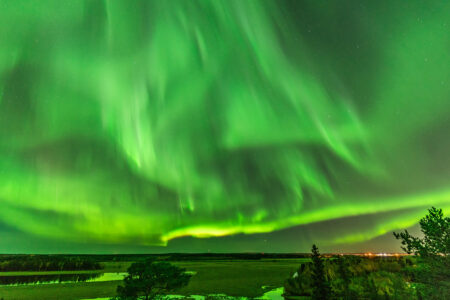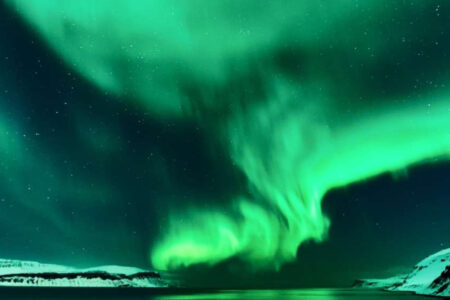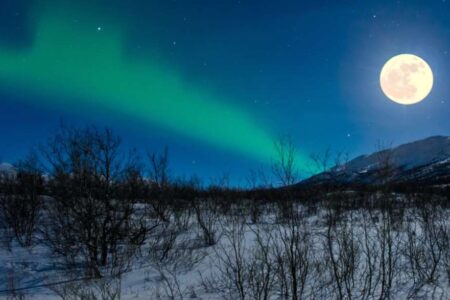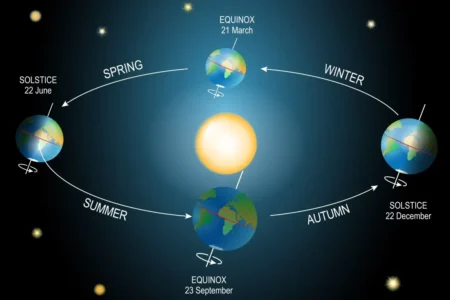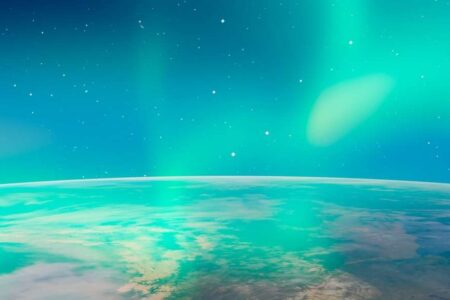If you’re heading to the Arctic in search of the northern lights, you want to be confident that you’re going to see those shimmering ribbons of colour dance across the night sky.
So — one of the questions our customers regularly ask us? What are their chances of seeing the northern lights on an aurora holiday?
Here, we share what we’ve learned over 15 years of planning aurora adventures — the science, the conditions, and the travel tips — to help you plan a trip where the odds are stacked in your favour.
What are your chances of seeing the northern lights on an aurora holiday?
We’d love to put a figure on it for you. But the truth is, the northern lights are an unpredictable natural phenomenon.
That said, here’s what we can tell you.
If you travel to Iceland, northern Norway, Swedish Lapland or Finnish Lapland, you have an excellent chance of seeing the northern lights. These regions lie in or near the Arctic Circle, making them some of the best destinations on Earth to witness the aurora.
The season matters too. The best time to see the northern lights is between September and early April — when Arctic nights are long and dark. During spring and summer, the sun in the Arctic rarely sets, which means skies are simply too bright for aurora viewing.
From there, your chances come down to a few key factors. Let’s take a closer look.
What affects the likelihood of seeing the northern lights?
There are three primary factors that affect the likelihood of seeing the northern lights. These are solar activity, location and weather conditions.
Solar activity
The northern lights are caused by solar activity. The sun releases particles, which are carried on the solar wind to our planet. Once they reach Earth, solar particles interact with the atmosphere to create the beautiful light show we know as the aurora borealis.
The sun shines every day so there is a constant stream of energy heading our way. But the number of particles that reach Earth varies from night to night, which means the intensity of the northern lights varies too.
To increase your chances of seeing the northern lights, you can travel to the Arctic when solar activity peaks.
We know that at the spring and autumn equinoxes (which occur every year) and at the height of the solar cycle (which occurs once every 11 years), solar activity peaks and makes big, bright northern lights displays more likely.
Location
The aurora borealis shines brightest in the Arctic Circle. And the further north you go, the more likely you are to see the northern lights, even when solar activity isn’t particularly intense.
However, your location within Arctic regions makes a difference. For example, your chances of seeing the northern lights in Reykjavik — Iceland’s capital city — are low. Light pollution makes it difficult to see the aurora.
To have the best chance of seeing the northern lights, you need to seek out remote areas, away from artificial light. The darker the skies, the better the conditions for seeing the aurora.
Weather
Weather conditions also affect the likelihood of seeing the northern lights. If there are clouds overhead, the aurora will be blocked from view. So you should head to places known for their stable weather patterns.
Abisko in Sweden has its own microclimate. The village is located close to a mountain range, which funnels weather fronts away from Abisko and results in a higher proportion of clear nights per year.
Our monitoring over many years shows that the average chance of seeing the northern lights over a 4-night aurora trip to Abisko is around 83%.
Similarly, the frozen seas of the Luleå Archipelago and the glaciers of South Iceland create pockets of clear sky, even when the weather in surrounding areas is less predictable.
Maximise your chances of seeing the aurora with Aurora Nights
Travel to the best northern lights locations and embark on exciting aurora excursions when you book with Aurora Nights — the aurora experts.
The types of aurora display you’re most likely to see
Every aurora experience is different and there are many different types of aurora displays. That’s because the strength of solar activity affects the patterns and colours of the northern lights. Here are the types of aurora displays you’re most likely to see.
Arc
Arcs are the most commonly sighted aurora displays. They’re visible at times of low solar activity and a low KP index. This type of display appears as a graceful, steady band and it lights up the whole of the night sky. Colours can range from milky white to shades of green.
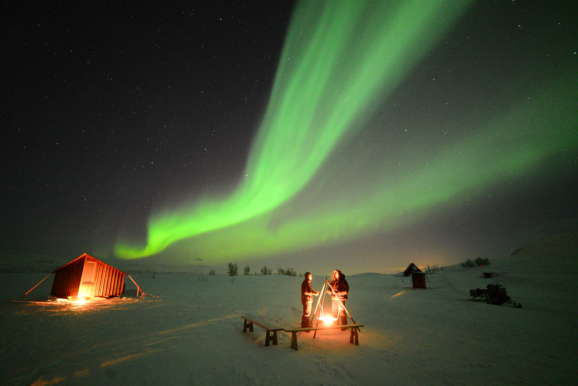
Band
A band is similar to an arc. But it has a wavy lower border instead of a smooth one. It curves and twists its way across the sky. Arcs can turn into bands during times of stronger solar activity.
Corona
The corona is one of the most spectacular northern lights displays. The sky can look as though it’s exploding from a central core. Coronas can be multi-coloured or just one colour — and we only tend to see these displays during times of intense solar activity.

Rising vapour column
This is a very distinctive aurora that seems to rise like a column of smoke, right from the surface of the Earth. This is, however, just an optical illusion as this dancing light show is taking place between 100 to 300 kilometres above the Earth’s surface.
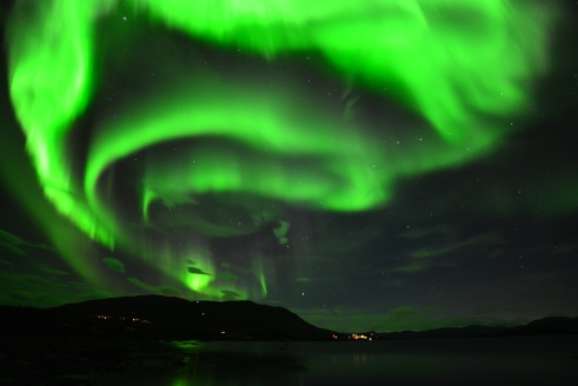
Rays
Rays are long vertical stripes, which move and create an auroral curtain. You’re more likely to see rays during periods of high solar activity.
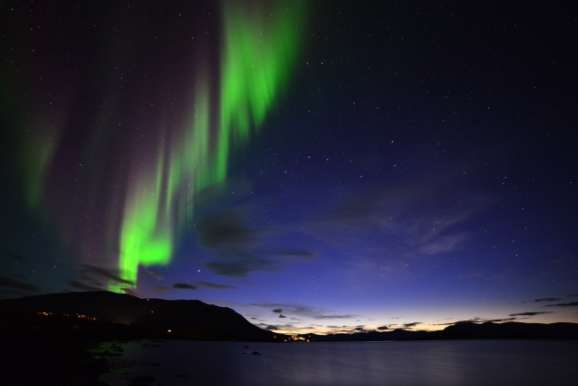
Are the northern lights visible all year round?
Technically, yes — the northern lights are active all year round. But visibility is another question.
From May to August, the Arctic sun rarely sets. And because sunlight is far brighter than the aurora, the northern lights are hidden from view during these months.
To have the best chance of seeing the aurora borealis, you should embark on a northern lights holiday between September and early April. During this time, nights are long and dark — giving you a much bigger window of opportunity for aurora sightings.
Here’s what to expect during different aurora seasons:
Chances of seeing the northern lights in September and October
In September and October, your chances of seeing the northern lights are very good. Skies across northern Europe are often clear and the absence of snow means there’s no extra light being reflected back into the sky.
You can also plan a trip to coincide with the autumn equinox, a time when solar activity peaks and bright aurora displays are more likely.
The only caveat? Autumn nights are shorter than those in midwinter, so your viewing window each day is a little narrower.
Chances of seeing the northern lights in November
November can be a mixed bag. While longer nights are ideal, this time of year tends to bring more unsettled weather and a high chance of cloud cover. As a result, it isn’t the best time of year to see the northern lights in northern Europe.
Chances of seeing the northern lights in December and January
If you can brave the cold, December and January are fantastic months for aurora hunters. Nights are long — and in some places, the sun doesn’t rise at all. That means you can catch a glimpse of the aurora at any time of the day or night.
However, the blanket of snow now covering the ground reflects light back into the sky, which means faint aurora displays aren’t always visible. Occasional cloudy nights are still common too.
Chances of seeing the northern lights in February and March
By February and March, weather conditions improve significantly. Snowfall becomes less frequent and skies are generally clearer, so you have an excellent chance of seeing the northern lights.
You also benefit from the spring equinox, which brings heightened solar activity. And — while nights are growing shorter — they are still long enough for excellent aurora visibility.
How to have the best chance of seeing the northern lights
If you want to maximise your chances of seeing the northern lights in all its glory? Here are our expert tips to help you plan the best possible aurora adventure.
1. Visit Arctic areas with low light pollution
Travel beyond Arctic towns and cities to areas with minimal light pollution. Stay in wilderness lodges and rural cabins, if possible. That way, you’re ready whenever the northern lights appear. The best countryside accommodation is optimised for northern lights viewing. Lights are turned down low and an aurora wakeup call comes as standard.
2. Keep your eye on the aurora forecast
As we mentioned earlier, solar activity varies from night to night. By checking the aurora forecast, you’ll know when geomagnetic activity is high — and when the chances of a display are strongest. The forecast breaks the night into three-hour segments, helping you plan your outings for optimal viewing.
3. Track the weather forecast too
Clouds can block even the brightest aurora display. So an up-to-date weather forecast is another essential for your aurora hunting toolkit. Keep tabs on the local weather, looking out for cloud-free skies, and be prepared to move to a different location if conditions change.
4. Travel with an aurora guide
An experienced aurora guide knows the local landscape, its microclimate and the solar forecast inside out. They can take you on exciting northern lights excursions. Whether you travel by minibus, snowmobile or husky sled, you can travel to dark, cloud-free skies where the northern lights are most likely to appear.
Ready to plan an unforgettable northern lights trip?
Now you know how to maximise your chances of seeing the northern lights, you need to decide where to go! Be inspired by our northern lights holidays in the Nordics:
- Northern lights holidays in Sweden
- Northern lights holidays in Finland
- Northern lights holidays in Iceland
- Northern lights holidays in Norway
Or contact the Aurora Nights team to chat through your holiday wish list.
